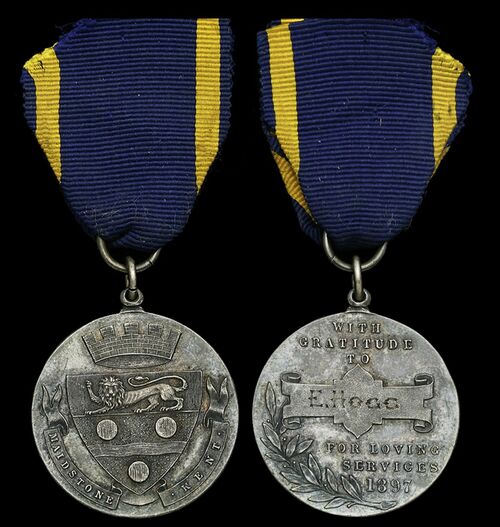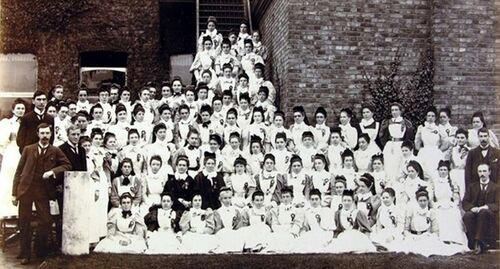Auction: 23002 - Orders, Decorations and Medals
Lot: 146
(x) A scarce Maidstone Typhoid Epidemic Medal awarded to Nurse E. Hogg, who also served in the Boer War and Great War
The Maidstone epidemic raged from September 1897 until January 1898, affecting some 2000 people, 143 of whom died. But for the stoic and devoted service of around 200 medical staff, including a young nurse Edith Cavell, the death toll would have been far greater
News of the epidemic swiftly hit the headlines, a fund for 'stricken Maidstone' attracting donations from all over Europe, in addition to one from Queen Victoria, whose husband Albert had succumbed to typhoid back in 1861
Mercifully - and in common with the recent Covid-19 pandemic - rapid advances were made in countering the disease, the first recorded trial of immunisation against typhoid being undertaken on volunteers from a psychiatric hospital near Maidstone by a team under Professor Almoth Wright: none of the 84 who received the new vaccine developed the disease
Maidstone Epidemic Medal 1897, silver, the reverse officially engraved, 'E. Hogg', good very fine
Emily Susannah Hogg was born in the Isle of Wight in December 1866 and served as a Probationer Nurse at the Royal Hampshire County Hospital between March 1889 and March 1890. Duly qualified, she became a private nurse in London and was likely a member of the London Corporation of Nurses.
Devoted service: Maidstone 1897-98
It was in this capacity - in common with other London nurses such as Edith Cavell - that she volunteered for duty in the Maidstone epidemic, the largest outbreak of typhoid fever ever reported in the United Kingdom. The 'Eurosurveillance' medical website takes up the story:
'It began September 1897 and ended in January 1898, affecting nearly 2000 people, 143 of whom died. At its peak 900 people contracted the disease in a two-week period. The cause was traced to contaminated mains water and its continuing spread was linked to the poor state of the drainage system and the housing of many of the victims.
It was a turning point in public health, featuring the first recorded trial of immunisation against typhoid and also of the sterilisation of a mains water supply, using chloride of lime. The typhoid immunisation trial was led by Professor Almoth Wright, who had developed the vaccine along with Richard Pfeiffer and Walter Kolle in 1896. Staff at a large psychiatric hospital near Maidstone were asked to volunteer for the trial: none of the 84 who received the new vaccine developed the disease, compared with four cases in the 120 who were not vaccinated. This established the vaccine's potential value and led to larger trials.
The chlorination of the water supply, organised by the bacteriologist Sims Woodhead, was a difficult procedure that required several attempts. Its success laid the foundations for continuous water treatment. The Maidstone outbreak may also have been the first in which telephones were used in the control of an epidemic, allowing doctors and nurses in the emergency hospitals to pass on information about cases.
The epidemic received unprecedented press attention. A fund for 'stricken Maidstone' attracted donations from all over Europe, particularly France and Italy. Queen Victoria, 78 years old and celebrating her 50th year on the throne at the time of the epidemic, sent a donation and a message of sympathy. Typhoid was common among the aristocracy: victims in the royal family included Victoria herself, Prince Albert (who died from typhoid in 1861), and two of their children.
The story of the outbreak reveals the plight of hop pickers - itinerant workers who helped with the hop and fruit harvest - as well as political and commercial pressures. The outbreak was costly and affected local businesses badly, with two exceptions: sales of bottled mineral water soared and breweries also benefited. Beer was considered safe because it was made using water from private wells.
Poor communications and false economies were singled out by the Public Inquiry, held in 1898: for example, no water samples had been taken for three months before the outbreak to save money, and there was confusion about the number of cases and when the outbreak had started. The numbers of cases recorded in the Public Inquiry were probably a gross underestimate as no precise case definition was used and cases in the workhouse for the homeless poor were not notified. It is likely that the introduction of typhoid immunisation and water sterilisation - a remarkable coincidence of two major public health advances during one outbreak - ensured that no epidemic as large has occurred in the U.K. since that time … '
Around 220 medical and municipal staff were subsequently awarded the Maidstone Epidemic Medal, in addition to a handful of Salvation Army staff.
Later service
Following the Maidstone epidemic, Hogg served under the auspices of the Army Nursing Service and the R.A.M.C. in South Africa during the Boer War. Her appointments would appear to have included No. 9 Stationary Hospital, Bulawayo Military Hospital and the Burgher Camp in Transvaal, latterly as a Matron; she was awarded the Queen's and King's South Africa Medals.
She also appears to have served in the West General Hospital back in the U.K. during the Great War.
Hogg died at St. Thomas's Hospital, London on 11 May 1931, leaving her estate of £6,779 to her friend, Edith Lee Martens, with whom she had lived at Golder's Green.
Subject to 5% tax on Hammer Price in addition to 20% VAT on Buyer’s Premium.
Sold for
£300
Starting price
£190







